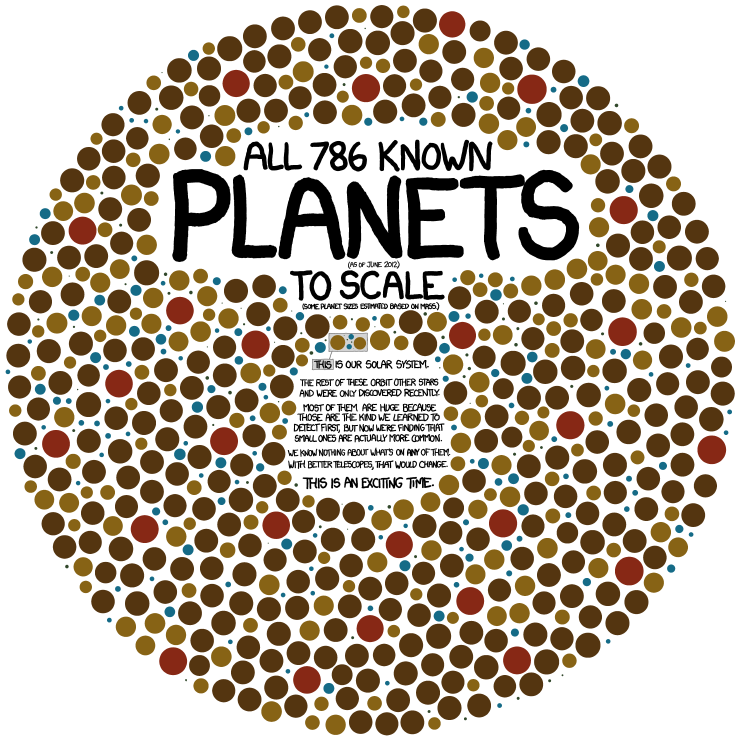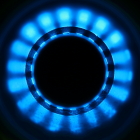|
Exoplanet News Thread
|
|
| OrbitalResonance | Date: Wednesday, 17.10.2012, 20:14 | Message # 46 |
 Astronaut
Group: Users
 United States
United States
Messages: 67
Status: Offline
| Waht are the different kinds of weird atmospheres that could exist out there?
I know we have mostly nitrogen here and on titan, mostly Co2 on Venus and Mars.
"We make our world significant by the courage of our questions and the depth of our answers" - Carl Sagan
|
| |
| |
| Watsisname | Date: Thursday, 18.10.2012, 00:28 | Message # 47 |
 Galaxy Architect
Group: Global Moderators
 United States
United States
Messages: 2613
Status: Offline
| It appears that in general the atmospheric composition is strongly related to the interior composition, and there are many possibilities. Unfortunately we only have the atmospheres of solar system bodies to go on, and a handful of spectroscopic observations of gas giants in other star systems, but with time we should be able to characterize the atmospheres of terrestrial exoplanets. Here is a basic run-down of what we understand so far:
1: "Primary" atmospheres from the original solar nebula, which contain cosmic abundances of Hydrogen and Helium. Giant planets generally follow this because they are massive enough to both accumulate and retain these light gases.
2: Outgassed atmospheres on planets massive enough to retain Hydrogen, and thus contain some mix of H2 and water vapor, CO, CO2, N2, CH4, etc. Which secondary gases are present and in what abundance depends on the planet's interior chemistry. Comet impacts might also be responsible for delivering additional water.
3: Outgassed atmospheres of terrestrial planets -- similar to above but without the hydrogen and helium since they escape. The atmospheres of such planets also often undergoes further evolution with time. For example, Mars is believed to have had a much denser atmosphere (enough to support widespread liquid water up until ~3.8GYa) but lost it due to its small mass. Venus also has evidence of once having a water-rich atmosphere, but may have lost it due photo-dissociation combined with a runaway GH effect. Earth is a very interesting case because our current atmosphere is very strongly a result of life. There was no appreciable oxygen until about 2.2GYa with the rise of photosynthesis. Methane can also be produced by biological activity (this might be the case on Mars!).
4: Silicate Atmospheres. On terrestrial planets with extremely high temperatures, gases like nitrogen, water vapor, CO2 and so forth will be able to escape. What's left behind are even heavier gases made up of vaporized silicates.
5: Miscellaneous? We have to remain humble and realize there may be a lot more out there that we haven't even thought of yet. Before the 1990s you'd have been called crazy if you proposed the existence of hot jupiters, and the 'diamond planet' (though I prefer to call these Carbon planets) detailed in the first post of this thread is another example of a planetary class we've only recently discovered. Similarly there may be even stranger types of atmospheres waiting to be found. The universe is a fascinating place! 
Sources:
Planetary Science, 2nd ed. (2011)
Exoplanet Atmospheres, Annual Reviews of Astronomy and Astrophysics (2010)
Silicate Atmospheres, The Astrophysical Journal (2009)

|
| |
| |
| Voekoevaka | Date: Thursday, 18.10.2012, 10:19 | Message # 48 |
 World Builder
Group: SE team
 France
France
Messages: 1016
Status: Offline
| Quote (OrbitalResonance) Waht are the different kinds of weird atmospheres that could exist out there?
The atmosphere with a very high pressure should be strange too. If the air is a supercritic fluid, this will have consequences on the geology, and there will be some "submarine" features in a desert.
It seems we could make a new version of it :

Want some music of mine ? Please go here !

|
| |
| |
| Destroyer123 | Date: Wednesday, 24.10.2012, 10:54 | Message # 49 |
|
Astronaut
Group: Users
 Sweden
Sweden
Messages: 64
Status: Offline
| This is not a specific thread but i just want to inform if anyone have missed out that a planet orbiting alpha centarey b. (i cant spell centaurey). I just though it was really cool that there is a planet at the closest start to earth. I know proxima is the closest but yeah. The sun must be a bright star in the night sky.
"Somewhere something incredibly is wating to be known"
Carl sagan
|
| |
| |
| Antza2 | Date: Wednesday, 24.10.2012, 11:09 | Message # 50 |
 World Builder
Group: Global Moderators
 Finland
Finland
Messages: 1049
Status: Offline
| There is an exoplanet thread already and this has been discussed there.
Quote (Destroyer123) (i cant spell centaurey)
It's spelled "centauri".
Quote (Destroyer123) The sun must be a bright star in the night sky.
It would be dimmer than Alpha Centauri is from Earths point of view.
Go to antza2.deviantart.com for cool photos!
Edited by Antza2 - Wednesday, 24.10.2012, 12:44 |
| |
| |
| Antza2 | Date: Wednesday, 24.10.2012, 11:15 | Message # 51 |
 World Builder
Group: Global Moderators
 Finland
Finland
Messages: 1049
Status: Offline
| Quote (DoctorOfSpace) Nearby Earthlike Planet Is Made Of Diamond
I suddenly remembered this:
Go to antza2.deviantart.com for cool photos!
|
| |
| |
| SpaceEngineer | Date: Wednesday, 24.10.2012, 16:16 | Message # 52 |
 Author of Space Engine
Group: Administrators
 Russian Federation
Russian Federation
Messages: 4800
Status: Offline
| BTW, our Sun from Alpha Centauri is visible in the Cassiopeia, continuing its "zig-zags", so its shape looks like "W\"

|
| |
| |
| HarbingerDawn | Date: Friday, 26.10.2012, 19:36 | Message # 53 |
 Cosmic Curator
Group: Administrators
 United States
United States
Messages: 8717
Status: Offline
| Increased confidence in Fomalhaut b's existence, refinement of its orbit, and additional constraints on its mass (<2 MJ)
http://www.nasa.gov/mission_pages/hubble/science/fomalhaut-exo.html
http://www.space.com/18238-undead-alien-planet-fomalhaut-b-zombie.html
All forum users, please read this!
My SE mods and addons
Phenom II X6 1090T 3.2 GHz, 16 GB DDR3 RAM, GTX 970 3584 MB VRAM
|
| |
| |
| DoctorOfSpace | Date: Friday, 26.10.2012, 22:05 | Message # 54 |
 Galaxy Architect
Group: Global Moderators
 Pirate
Pirate
Messages: 3600
Status: Offline
| Quote (HarbingerDawn) http://www.nasa.gov/mission_pages/hubble/science/fomalhaut-exo.html
Man that is far
2spooky4me
Intel Core i7-5820K 4.2GHz 6-Core Processor
G.Skill Ripjaws V Series 32GB (4 x 8GB) DDR4-2400 Memory
EVGA GTX 980 Ti SC 6GB
|
| |
| |
| HarbingerDawn | Date: Friday, 26.10.2012, 22:17 | Message # 55 |
 Cosmic Curator
Group: Administrators
 United States
United States
Messages: 8717
Status: Offline
| Quote (DoctorOfSpace) 2spooky4me 
All forum users, please read this!
My SE mods and addons
Phenom II X6 1090T 3.2 GHz, 16 GB DDR3 RAM, GTX 970 3584 MB VRAM
Edited by HarbingerDawn - Friday, 26.10.2012, 22:28 |
| |
| |
| Antza2 | Date: Tuesday, 30.10.2012, 18:17 | Message # 56 |
 World Builder
Group: Global Moderators
 Finland
Finland
Messages: 1049
Status: Offline
|
Go to antza2.deviantart.com for cool photos!
|
| |
| |
| OrbitalResonance | Date: Thursday, 08.11.2012, 04:01 | Message # 57 |
 Astronaut
Group: Users
 United States
United States
Messages: 67
Status: Offline
| Habitable zone super earth in the HD 40307 system.

"We make our world significant by the courage of our questions and the depth of our answers" - Carl Sagan
|
| |
| |
| smjjames | Date: Thursday, 08.11.2012, 06:41 | Message # 58 |
|
World Builder
Group: Users
 United States
United States
Messages: 913
Status: Offline
| The article from Space.com: http://www.space.com/18393-a....7g.html
Even if it turns out to be a small warm neptune with no true soilid surface (until you hit it's primordial rocky core anyway), it's moons could very well support life.
Anyways, If given a density simiilar to that of Earth, I wonder what it's gravity would be.

Edited by smjjames - Thursday, 08.11.2012, 06:45 |
| |
| |
| SpaceEngineer | Date: Thursday, 08.11.2012, 08:29 | Message # 59 |
 Author of Space Engine
Group: Administrators
 Russian Federation
Russian Federation
Messages: 4800
Status: Offline
| According to article, this planet have big eccentricity - 0.29. This is not good for life.
Quote (smjjames) Even if it turns out to be a small warm neptune with no true soilid surface (until you hit it's primordial rocky core anyway), it's moons could very well support life.
If this planet have a moon with mass of 1/81 of planet's mass (as our Moon), it's mass will be 0.08 Earth's mass, a bit lower than Mars.

|
| |
| |
| smjjames | Date: Thursday, 08.11.2012, 09:13 | Message # 60 |
|
World Builder
Group: Users
 United States
United States
Messages: 913
Status: Offline
| Quote (SpaceEngineer) According to article, this planet have big eccentricity - 0.29. This is not good for life.
Quote (smjjames)
Even if it turns out to be a small warm neptune with no true soilid surface (until you hit it's primordial rocky core anyway), it's moons could very well support life.
If this planet have a moon with mass of 1/81 of planet's mass (as our Moon), it's mass will be 0.08 Earth's mass, a bit lower than Mars.
On the eccentricity: Oh. Maybe not multicellular life then (or just aquatic).
For the moon: Havning a moon with a thick atmosphere isn't outside the realm of possibility. I don't know how strong a magnetic field from a gas giant (or gas/ice dwarf as this planet might be classified) has to be to protect a moon from losing it's atmosphere, but it could happen.
Also, despite being smaller than mars, if such a moon is at the right distance, it should get enough tidal stretching to keep its core from cooling too much and therefore, keep a magnetic field.

|
| |
| |